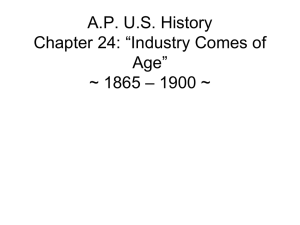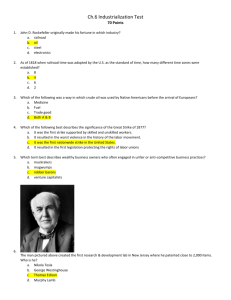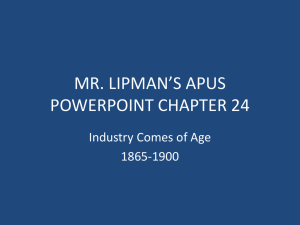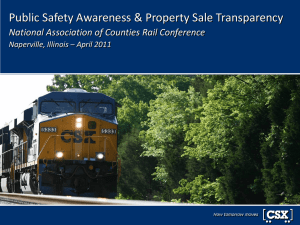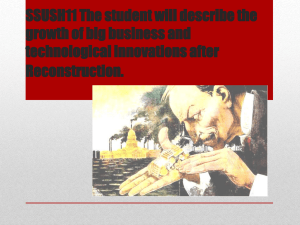Chapter 24 - Ludlow Independent Schools
advertisement
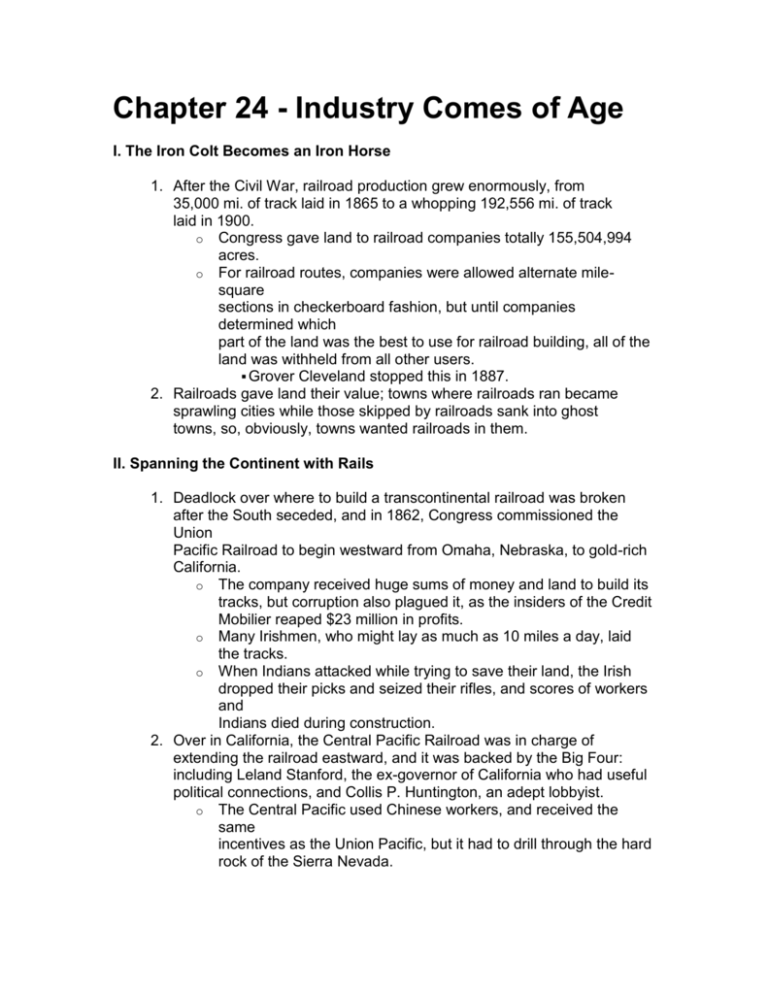
Chapter 24 - Industry Comes of Age I. The Iron Colt Becomes an Iron Horse 1. After the Civil War, railroad production grew enormously, from 35,000 mi. of track laid in 1865 to a whopping 192,556 mi. of track laid in 1900. o Congress gave land to railroad companies totally 155,504,994 acres. o For railroad routes, companies were allowed alternate milesquare sections in checkerboard fashion, but until companies determined which part of the land was the best to use for railroad building, all of the land was withheld from all other users. Grover Cleveland stopped this in 1887. 2. Railroads gave land their value; towns where railroads ran became sprawling cities while those skipped by railroads sank into ghost towns, so, obviously, towns wanted railroads in them. II. Spanning the Continent with Rails 1. Deadlock over where to build a transcontinental railroad was broken after the South seceded, and in 1862, Congress commissioned the Union Pacific Railroad to begin westward from Omaha, Nebraska, to gold-rich California. o The company received huge sums of money and land to build its tracks, but corruption also plagued it, as the insiders of the Credit Mobilier reaped $23 million in profits. o Many Irishmen, who might lay as much as 10 miles a day, laid the tracks. o When Indians attacked while trying to save their land, the Irish dropped their picks and seized their rifles, and scores of workers and Indians died during construction. 2. Over in California, the Central Pacific Railroad was in charge of extending the railroad eastward, and it was backed by the Big Four: including Leland Stanford, the ex-governor of California who had useful political connections, and Collis P. Huntington, an adept lobbyist. o The Central Pacific used Chinese workers, and received the same incentives as the Union Pacific, but it had to drill through the hard rock of the Sierra Nevada. 3. In 1869, the transcontinental rail line was completed at Promontory Point near Ogden, Utah; in all, the Union Pacific built 1,086 mi. of track, compared to 689 mi. by the Central Pacific. III. Binding the Country with Railroad Ties 1. Before 1900, four other transcontinental railroads were built: o The Northern Pacific Railroad stretched from Lake Superior to the Puget Sound and was finished in 1883. o The Atchison, Topeka, and Santa Fe stretched through the Southwest deserts and was completed the following year, in 1884. o The Southern Pacific (completed in 1884) went from New Orleans to San Francisco. o The Great Northern ran from Duluth to Seattle and was the creation of James J. Hill, probably the greatest railroad builder of all. 2. However, many pioneers over-invested on land, and the banks that supported them often failed and went bankrupt when the land wasn’t worth as much as initially thought. IV. Railroad Consolidation and Mechanization 1. Older eastern railroads, like the New York Central, headed by Cornelius Vanderbilt, often financed the successful western railroads. 2. Advancements in railroads included the steel rail, which was stronger and more enduring than the iron rail, the Westinghouse air brake which increased safety, the Pullman Palace Cars which were luxurious passenger cars, and telegraphs, double-racking, and block signals. o Nevertheless, train accidents were common, as well as death. V. Revolution by Railways 1. Railroads stitched the nation together, generated a huge market and lots of jobs, helped the rapid industrialization of America, and stimulated mining and agriculture in the West by bringing people and supplies to and from the areas where such work occurred. 2. Railroads helped people settle in the previously harsh Great Plains. 3. Due to railroads, the creation of four national time zones occurred on November 18, 1883, instead of each city having its own time zone (that was confusing to railroad operators). 4. Railroads were also the makers of millionaires and the millionaire class. VI. Wrongdoing in Railroading 1. Railroads were not without corruption, as shown by the Credit Mobilier scandal. 2. Jay Gould made millions embezzling stocks from the Erie, Kansas Pacific, the Union Pacific, and the Texas and Pacific railroad companies. 3. One method of cheap moneymaking was called “stock watering,” in which railroad companies grossly over-inflated the worth of their stock and sold them at huge profits. 4. Railroad owners abused the public, bribed judges and legislatures, employed arm-twisting lobbyists, elected their own to political office, gave rebates (which helped the wealthy but not the poor), and used free passes to gain favor in the press. 5. As time passed, though, railroad giants entered into defensive alliances to show profits, and began the first of what would be called trusts, although at that time they were called “pools.” A pool (AKA, a “cartel”) is a group of supposed competitors who agree to work together, usually to set prices. VII. Government Bridles the Iron Horse 1. People were aware of such injustice, but were slow to combat it. 2. The Grange was formed by farmers to combat such corruption, and many state efforts to stop the railroad monopoly occurred, but they were stopped when the Supreme Court issued its ruling in the Wabash case, in which it ruled that states could not regulate interstate commerce, such as trains. 3. The Interstate Commerce Act, passed in 1887, banned rebates and pools and required the railroads to publish their rates openly (so as not to cheat customers), and also forbade unfair discrimination against shippers and banned charging more for a short haul than for a long one. o It also set up the Interstate Commerce Commission (ICC) to enforce this. 4. The act was not a victory against corporate wealth, as people like Richard Olney, a shrewd corporate lawyer, noted that they could use the act to their advantage, but it did represent the first attempt by Congress to regulate businesses for society’s interest. VIII. Miracles of Mechanization 1. In 1860, the U.S. was the 4th largest manufacturer in the world, but by 1894, it was #1, why? o Now-abundant liquid capital. o Fully exploited natural resources (like coal, oil, and iron, the iron came from the Minnesota-Lake Superior region which yielded the rich iron deposits of the Mesabi Range). o Massive immigration made labor cheap. o American ingenuity played a vital role, as such inventions like mass production (from Eli Whitney) were being refined and perfected. Popular inventions included the cash register, the stock ticker, the typewriter, the refrigerator car, the electric dynamo, and the electric railway, which displaced animal-drawn cars. 2. In 1876, Alexander Graham Bell invented the telephone and a new age was launched. 3. Thomas Edison, the “Wizard of Menlo Park,” was the most versatile inventor, who, while best known for his electric light bulb, also cranked out scores of other inventions. IX. The Trust Titan Emerges 1. Industry giants used various ways to eliminate competition and maximize profits. o Andrew Carnegie used a method called “vertical integration,” which meant that he bought out and controlled all aspects of an industry (in his case, he mined the iron, transported it, refined it, and turned it into steel, controlling all parts of the process). o John D. Rockefeller, master of “horizontal integration,” simply allied with or bought out competitors to monopolize a given market. He used this method to form Standard Oil and control the oil industry by forcing weaker competitors to go bankrupt. 2. These men became known for their trusts, giant, monopolistic corporations. o J.P. Morgan also placed his own men on the boards of directors of other rival competitors to gain influence there and reduce competition, a process called “interlocking directorates.” X. The Supremacy of Steel 1. In Lincoln’s day, steel was very scarce and expensive, but by 1900, Americans produced as much steel as England and Germany combined. 2. This was due to an invention that made steel-making cheaper and much more effective: the Bessemer process, which was named after an English inventor even though an American, William Kelly, had discovered it first: o Cold air blown on red-hot iron burned carbon deposits and purified it. o America was one of the few nations that had a lot of coal for fuel, iron for smelting, and other essential ingredients for steel making, and thus, quickly became #1. XI. Carnegie and Other Sultans of Steel 1. Andrew Carnegie started off as a poor boy in a bad job, but by working hard, assuming responsibility, and charming influential people, he worked his way up to wealth. 2. He started in the Pittsburgh area, but he was not a man who liked trusts; still, by 1900, he was producing 1/4 of the nation’s Bessemer steel, and getting $25 million a year. 3. J. Pierpont Morgan, having already made a fortune in the banking industry and in Wall Street, was ready to step into the steel tubing industry, but Carnegie threatened to ruin him, so after some tense negotiation, Morgan bought Carnegie’s entire business at $400 million (this was before income tax). But Carnegie, fearing ridicule for possessing so much money, spent the rest of his life donating $350 million of it to charity, pensions, and libraries. o Meanwhile, Morgan took Carnegie’s holdings, added others, and launched the United States Steel Corporation in 1901, a company that became the world’s first billion-dollar corporation (it was capitalized at $1.4 billion). XII. Rockefeller Grows an American Beauty Rose 1. In 1859, a man named Drake first used oil to get money, and by the 1870s, kerosene, a type of oil, was used to light lamps all over the nation. 2. However, by 1885, 250,000 of Edison’s electric light bulbs were in use, and the electric industry soon rendered kerosene obsolete, just as kerosene had made whale oil obsolete. 3. Oil, however, was just beginning with the gasoline-burning internal combustion engine. 4. John D. Rockefeller, ruthless and merciless, organized the Standard Oil Company of Ohio in 1882 (five years earlier, he had already controlled 95% of all the oil refineries in the country). 5. Rockefeller crushed weaker competitors—part of the natural process according to him—but his company did produce superior oil at a cheaper price. 6. Other trusts, which also generally made better products at cheaper prices, emerged, such as the meat industry of Gustavus F. Swift and Philip Armour. XIII. The Gospel of Wealth 1. Many of the newly rich had worked from poverty to wealth, and thus felt that some people in the world were destined to become rich and then help society with their money. This was the “Gospel of Wealth.” 2. “Social Darwinism” applied Charles Darwin’s survival-of-the-fittest theories to business. It said the reason a Carnegie was at the top of the steel industry was that he was most fit to run such a business. 3. The Reverend Russell Conwell of Philadelphia became rich by delivering his lecture, “Acres of Diamonds” thousands of times, and in it he preached that poor people made themselves poor and rich people made themselves rich; everything was because of one’s actions only. 4. Corporate lawyers used the 14th Amendment to defend trusts, the judges agreed, saying that corporations were legal people and thus entitled to their property, and plutocracy ruled. XIV. Government Tackles the Trust Evil 1. In 1890, the Sherman Anti-Trust Act was signed into law; it forbade combinations (trusts, pools, interlocking directorates, holding companies) in restraint of trade, without any distinction between “good” and “bad” trusts. o It proved ineffective, however, because it couldn’t be enforced. o Not until 1914 was it properly enforced and those prosecuted for violating the law were actually punished. XV. The South in the Age of Industry 1. The South remained agrarian despite all the industrial advances, though James Buchanan Duke developed a huge cigarette industry in the form of the American Tobacco Company and made many donations to what is now Duke University. 2. Men like Henry W. Grady, editor of the Atlanta Constitution newspaper urged the South to industrialize. 3. However, many northern companies set rates to keep the South from gaining any competitive edge whatsoever, with examples including the rich deposits of iron and coal near Birmingham, Alabama, and the textile mills of the South. o However, cheap labor led to the creation of many jobs, and despite poor wages, many white Southerners saw employment as a blessing. 4. The Impact of the New Industrial Revolution on America o As the Industrial Revolution spread in America, the standard of living rose, immigrants swarmed to the U.S., and early Jeffersonian ideals about the dominance of agriculture fell. o Women, who had swarmed to factories and had been encouraged by recent inventions, found new opportunities, and the “Gibson Girl,” created by Charles Dana Gibson, became the romantic ideal of the age. The Gibson Girl was young, athletic, attractive, and outdoorsy (not the stay-at-home mom type). However, many women never achieved this, and instead toiled in hard work because they had to do so in order to earn money. 5. A nation of farmers was becoming a nation of wage earners, but the fear of unemployment was never far, and the illness of a breadwinner (the main wage owner) in a family was disastrous. 6. Strong pressures in foreign trade developed as the tireless industrial machine threatened to flood the domestic market. XVI. In Unions There Is Strength 1. With the inflow of immigrants providing a labor force that would work for low wages and in poor environments, the workers who wanted to improve their conditions found that they could not, since their bosses could easily hire the unemployed to take their places. 2. Corporations had many weapons against strikers, such as hiring strikebreakers or asking the courts to order strikers to stop striking, and if they continued, to bring in troops. Other methods included hiring “scabs” or replacements or “lockouts” to starve strikers into submission, and often, workers had to sign “ironclad oaths” or “yellow dog contracts” which banned them from joining unions. Workers could be “blacklisted,” or put on a list and denied privileges elsewhere. 3. The middle-class, annoyed by the recurrent strikes, grew deaf to the workers’ outcry. 4. The view was that people like Carnegie and Rockefeller had battled and worked hard to get to the top, and workers could do the same if they “really” wanted to improve their situations. o XVII. Labor Limps Along 1. The Civil War put a premium on labor, which helped labor unions grow. 2. The National Labor Union, formed in 1866, represented a giant boot stride by workers and attracted an impressive total of 600,000 members, but it only lasted six years. o However, it excluded Chinese and didn’t really try to get Blacks and women to join. o It worked for the arbitration of industrial disputes and the eight-hour workday, and won the latter for government workers, but the depression of 1873 knocked it out. 3. A new organization, the Knights of Labor, was begun in 1869 and continued secretly until 1881. This organization was similar to the National Labor Union. o It only barred liquor dealers, professional gamblers, lawyers, bankers, and stockbrokers, and they campaigned for economic and social reform. o Led by Terence V. Powderly, the Knights won a number of strikes for the eight-hour day, and when they staged a successful strike against Jay Gould’s Wabash Railroad in 1885, membership mushroomed to 3/4 of a million workers. XVIII. Unhorsing the Knights of Labor 1. However, the Knights became involved in a number of May Day strikes of which half failed. 2. In Chicago, home to about 80,000 Knights and a few hundred anarchists that advocated a violent overthrow of the American government, tensions had been building, and on May 4, 1886, Chicago police were advancing on a meeting that had been called to protest brutalities by authorities when a dynamite bomb was thrown, killing or injuring several dozen people. Eight anarchists were rounded up yet no one could prove that they had any association with the bombing, but since they had preached incendiary doctrines, the jury sentenced five of them to death on account of conspiracy and gave the other three stiff prison terms. o In 1892, John P. Altgeld, a German-born Democrat was elected governor of Illinois and pardoned the three survivors after studying the case extensively. o He received violent verbal abuse for that and was defeated during re-election. 3. This so-called Haymarket Square Bombing forever associated the Knights of Labor with anarchists and lowered their popularity and effectiveness; membership declined, and those that remained fused with other labor unions. o XIX. The AF of L to the Fore 1. In 1886, Samuel Gompers founded the American Federation of Labor. o It consisted of an association of self-governing national unions, each of which kept its independence, with the AF of L unifying overall strategy. 2. Gompers demanded a fairer share for labor. o He simply wanted “more,” and sought better wages, hours, and working conditions. 3. The AF of L established itself on solid but narrow foundations, since it tried to speak for all workers but fell far short of that. o Composed of skilled laborers, it was willing to let unskilled laborers fend for themselves. Critics called it “the labor trust.” 4. From 1881 to 1900, there were over 23,000 strikes involving 6,610,000 workers with a total loss to both employers and employees of about $450 million. o Perhaps the greatest weakness of labor unions was that they only embraced a small minority—3%—of all workers. 5. However, by 1900, the public was starting to concede the rights of workers and beginning to give them some or most of what they wanted. o In 1894, Labor Day was made a legal holiday. 6. A few owners were beginning to realize that losing money to fight labor strikes was useless, though most owners still dogmatically fought labor unions. 7. If the age of big business had dawned, the age of big labor was still some distance over the horizon


